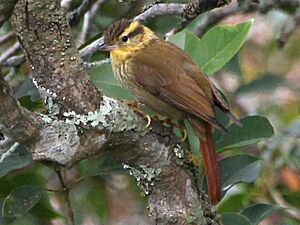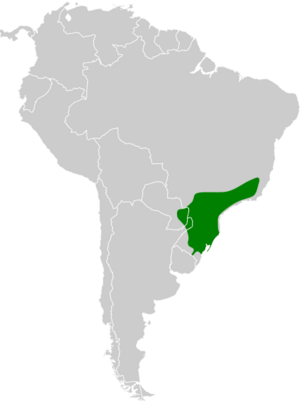Sharp-billed treehunter facts for kids
Quick facts for kids Sharp-billed treehunter |
|
|---|---|
 |
|
| Subspecies camargoi | |
| Conservation status | |
| Scientific classification | |
| Genus: |
Heliobletus
|
| Species: |
contaminatus
|
 |
|
The sharp-billed treehunter (Heliobletus contaminatus) is a small bird. It is part of the ovenbird family, called Furnariidae. This bird lives in parts of South America. You can find it in Argentina, Brazil, Paraguay, and Uruguay. It is sometimes also called the sharp-billed xenops.
Contents
Bird Classification
Scientists group living things into categories. This helps us understand how they are related. The sharp-billed treehunter belongs to a group called Heliobletus. It is the only known bird in this group.
There are two main types, or subspecies, of the sharp-billed treehunter:
- H. c. contaminatus
- H. c. camargoi
Scientists are still studying these subspecies. They might change their names in the future. Some studies show that this bird is closely related to birds in the Philydor group. These are called "sister species."
What Does It Look Like?
The sharp-billed treehunter is a small bird. It is about 12 to 13 centimeters (5 inches) long. It weighs about 13 to 15 grams (half an ounce). Both male and female birds look the same.
This bird has a short, pointed beak. The beak curves slightly downwards.
Here are some features of its appearance:
- It has a wide, golden-buff stripe above its eye. This stripe is called a supercilium.
- There is a dark brownish-black band behind its eye.
- Its crown (the top of its head) is dark brownish-black. It has golden-olive streaks.
- Its back and rump are dull olive-brown.
- Its tail is dark reddish-brown. The very tips of the tail feathers are bare.
- Its throat is pale yellowish-buff.
- Its chest is a lighter yellowish-buff with dull olive-brown streaks.
- Its belly is plain dull olive-brown.
Young sharp-billed treehunters look similar to adults. Their supercilium and streaks are more yellowish-orange. The streaks are also less clear. The H. c. camargoi subspecies has wider, pale golden-buff streaks on its back. It also has more streaks on its chest and belly.
Where It Lives
The sharp-billed treehunter lives in humid forests. These can be lowland forests or mountain forests. It lives from sea level up to about 1,830 meters (6,000 feet) high.
The H. c. contaminatus subspecies is found in southeastern Brazil. This includes the states of Minas Gerais, Espírito Santo, São Paulo, and Rio de Janeiro.
The H. c. camargoi subspecies lives further south. It is found from São Paulo, Brazil, south through Rio Grande do Sul. It also lives in eastern Paraguay, northeastern Argentina (Misiones Province), and extreme northeastern Uruguay.
Bird Behavior
Movement
The sharp-billed treehunter stays in the same area all year. It does not migrate.
What It Eats
This bird eats arthropods. These are small creatures like insects and spiders. It usually hunts for food alone or in pairs. Often, it joins a mixed-species feeding flock. This is a group of different bird species hunting together.
It mostly looks for food in the middle and top parts of the forest trees. Sometimes, it will search closer to the ground. It climbs and hangs upside down. It picks and pulls its prey from branches, leaves, and plants growing on trees.
Reproduction and Life Cycle
Scientists do not know much about how the sharp-billed treehunter breeds. More research is needed to understand its nesting habits and how it raises its young.
Bird Sounds
The sharp-billed treehunter's song is a short, harsh, metallic trill. It sounds like a slow, tinkling sound. Sometimes, it adds squeaky notes. Its call is a soft "tick" sound.
Conservation Status
The IUCN (International Union for Conservation of Nature) checks on animals. They have listed the sharp-billed treehunter as "Least Concern." This means it is not in immediate danger of disappearing.
However, its population size is not fully known. Scientists believe its numbers are going down. One reason for this is that many forests where it lives are being cut down. This reduces the places where the bird can live.
The bird is common in most of its range. But it is rare in Paraguay. It lives in several protected areas. These areas help keep its habitat safe.
Images for kids



